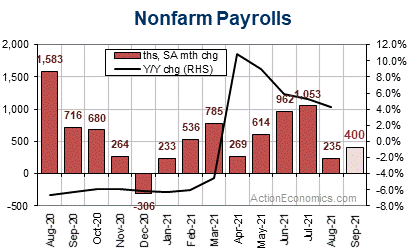A slightly better than expected ADP report has taken some of the bearish edges off of Wall Street futures.
But it is still the same story with stagflation risks, multi-year highs on WTI oil, concerns over China, monetary policy tightening, uncertainties over the FOMC and Powell’s re-nomination, and US default fears. As expected, the RBNZ hiked rates to add to the bearish tone all around. China remained on holiday.
The JPN225 finished -1.05% lower. European bourses have plunged with the GER30 down -2.2% and the UK100 -1.77% lower. US futures are in the red with the USA100 down -1.2%, the USA500 -1.1% lower and the USA30 off -0.94%. Treasuries and European yields are 2 to 3 bps cheaper with the 10-year Treasury at 1.550% and the Bund at -0.168%, and the Gilt at 1.115%. Italy’s BTP is 5.5 bps higher at 0.912%. The JGB cheapened 1.2 bps to 0.072%. The EU promised swift action to prevent spiraling natural gas prices from stifling the recovery, but the bearish effects on growth and inflation expectations have rippled across markets. European data were weaker than expected today, with a larger than expected decline in German manufacturing orders, with Eurozone retail sales also rising less than hoped. Also, hotter Korean inflation exacerbated global inflation fears.
However the highlight of the day was the ADP report as a key indicator of NonFarm payrolls on Friday. US ADP reported private payrolls increased 568k in September, a little better than expected, but August was revised down to a 340k (was 374k) increase after July’s 326k gain. Employment in the service sector continues to pace the bulk of the gains, rising 466k versus the prior 297k increase. Employment in leisure/hospitality led the month’s pick up, adding 226k, the best since the 363k pop in June. Jobs in education/health were up 66k, with professional business services adding 61k. Trade/transport employment increased 54k. Jobs in the goods sector rose an unusually strong 102k after the 42k August increase, nearly 3x the 3-month average of 38k. Manufacturing and construction jobs were up 49k and 46k, respectively, also beating the prior several months.
The US Dollar was little changed following the ADP jobs report which revealed a better than expected rise in private payrolls in September. EURUSD sits near trend lows at 1.1550, while USDJPY is up a few points over 111.35. USDCAD rallied to 1.2648 highs into the US open, up from 1.2576 seen just after Tuesday’s close. The usual combination of a pullback in oil prices, along with risk-off conditions which prompted safe-haven USD buying was behind the move higher. Since then, the pairing has pulled back to 1.2610, as the Greenback edges off its highs overall. Equity futures continue to indicate a lower Wall Street open, while yields remain firmer but off their earlier highs.
The ADP report signals slight upside risk for Friday’s jobs data, though the ADP data remain an unreliable predictor since 2020 of monthly payroll swings . Overall, the supply chain disruptions and price spikes have prompted mark-downs in NFP forecasts over the last 2 weeks, leaving a September NonFarm Payroll estimate of 400k and a Q3 GDP growth estimate of 3.6%.

The payroll gain is above the recent lean 235k August rise, but below the 503k average thus far in 2021. The September workweek should be seen at 34.7, that still leaves a solid 0.6% September hours-worked rise. Hourly earnings gain is seen at 0.3% and a jobless rate drop to 5.1% from 5.2%. A big portion of lower paid workers remain outside the labor force, leaving a smaller work force with longer workweeks, and a higher level of pay.
A solid growth has forecasted at 4.4% y/y increase in September despite the headwind from elevated comparisons. Growth in hourly earnings was gradually climbing from the 2% trough area between 2010 and 2014 to the 3%+ area up to the start of the pandemic. The underlying trend for y/y wage growth is likely well above the prior cycle’s peak once we move past distortions from base effects.
Claims improvement is moderating, vehicle sales plunged further on supply shortages, and both producer and consumer sentiment are falling from Q2 peaks.
Click here to access our Economic Calendar
Andria Pichidi
Market Analyst
Disclaimer: This material is provided as a general marketing communication for information purposes only and does not constitute an independent investment research. Nothing in this communication contains, or should be considered as containing, an investment advice or an investment recommendation or a solicitation for the purpose of buying or selling of any financial instrument. All information provided is gathered from reputable sources and any information containing an indication of past performance is not a guarantee or reliable indicator of future performance. Users acknowledge that any investment in Leveraged Products is characterized by a certain degree of uncertainty and that any investment of this nature involves a high level of risk for which the users are solely responsible and liable. We assume no liability for any loss arising from any investment made based on the information provided in this communication. This communication must not be reproduced or further distributed without our prior written permission.




















